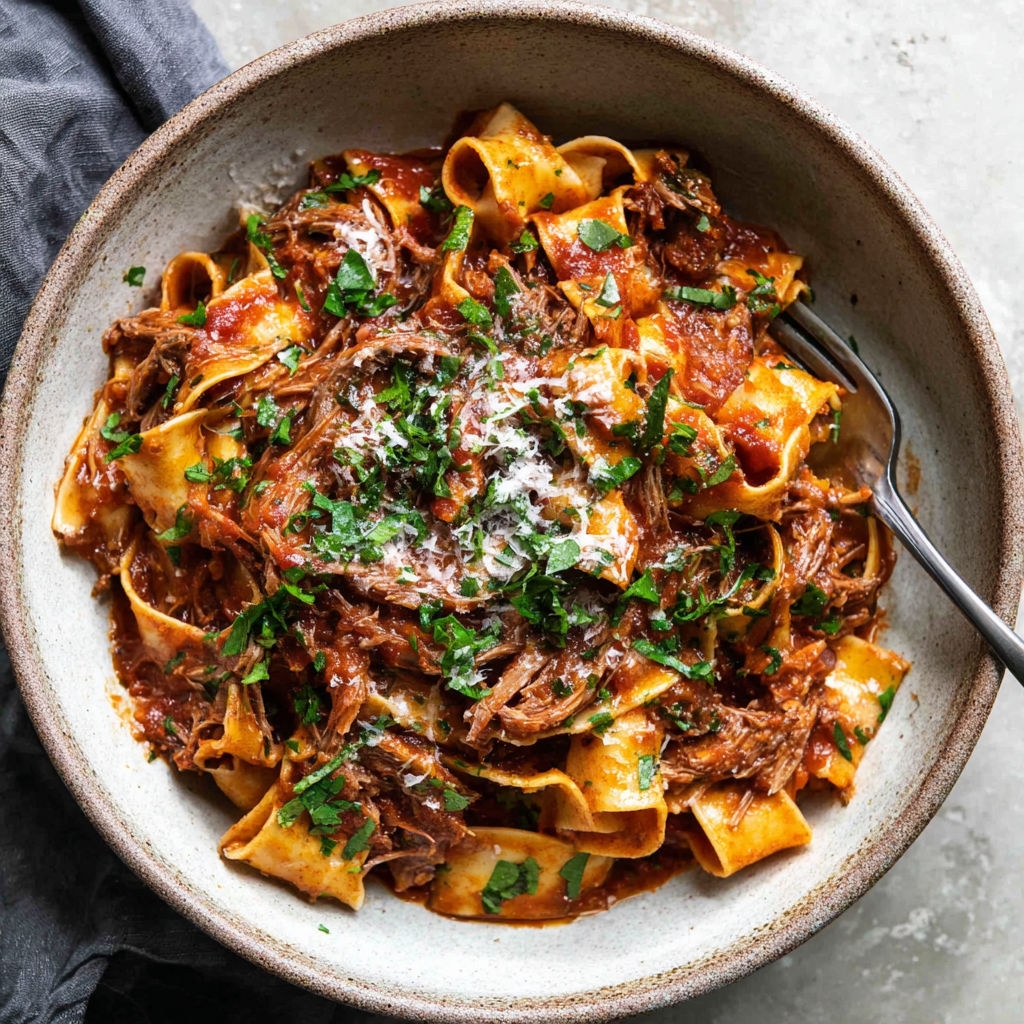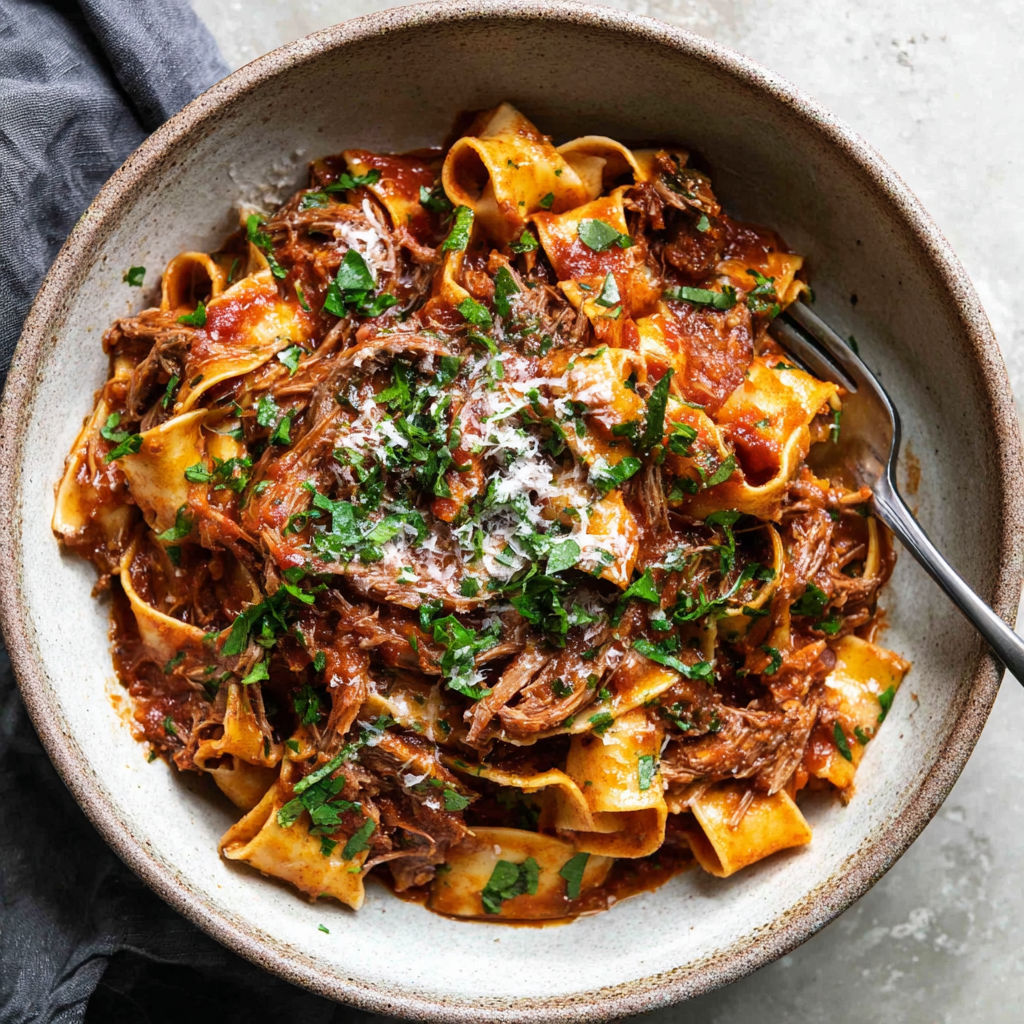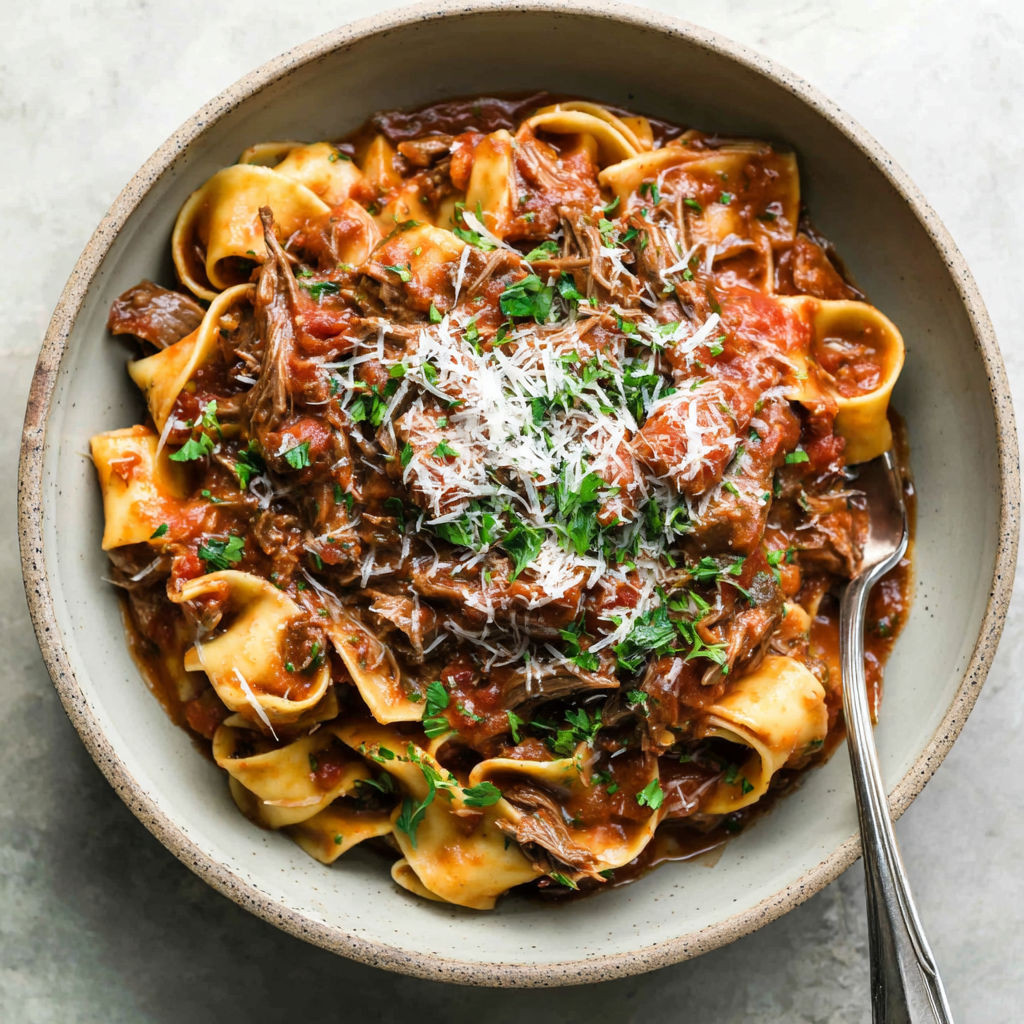 Save
Save
Slow cooked shredded beef ragu pasta is pure comfort food and an example of Italian home cooking at its best. With minimal effort, simple ingredients transform in the pot to a rich savory sauce that clings to every strand of pasta. When I first made this, the aroma had the whole house lingering and now it is one of those “special dinner” requests. It works beautifully for feeding a crowd or prepping ahead since the leftovers only get better with time.
When I first cooked this for a Sunday dinner with friends, everyone went silent at the first bite—a sure sign of a winner. Now it is a staple for when I want cozy, classic Italian with a minimum of fuss.
Gather Your Ingredients
- Chuck beef or other slow cooking beef cut: Cut into four large pieces—rich flavor and shreds perfectly after slow cooking. Look for beef with good marbling.
- Salt and black pepper: Essential for seasoning and building flavor foundations
- Olive oil: Use a good quality extra virgin for sautéing and depth
- Garlic minced: Brings that signature Italian aroma
- Onion diced: Sweetness and structure to the sauce
- Carrots diced: Traditional base for flavor and sweetness
- Celery diced: Adds a light freshness and complexity
- Crushed canned tomatoes: Opt for fire-roasted or Italian brands for best taste
- Tomato paste: Intensifies the tomato flavor
- Beef bouillon cubes crumbled or use beef stock: Boosts umami and deepens the sauce
- Red wine full bodied like merlot or cabernet or substitute beef broth: Builds richness
- Water: Helps control consistency while simmering
- Dried or fresh thyme: Herbaceous notes for depth
- Dried bay leaves: Rounds out the long-cooked flavor
- Dried pappardelle or wide pasta: Ideal for catching every bit of sauce
- Freshly grated parmesan or parmigiano reggiano: A salty finishing touch
- Fresh parsley finely chopped optional: Brightens the dish at the end
How to Make It
- Prepare the beef:
- Pat beef dry with paper towels and sprinkle generously with salt and black pepper. This not only seasons the meat but also helps form a good sear.
- Sear the beef:
- Heat one tablespoon of olive oil in a heavy based pot over high heat. Add the beef pieces and sear each side until they turn a deep brown crust about three to five minutes total. Remove the beef to a plate and set aside.
- Sauté the aromatics:
- Reduce the heat to medium low. Add two more tablespoons of olive oil to the same pot. Stir in the minced garlic and diced onion sautéing for two minutes just until fragrant but not browned. Add the carrots and celery keeping the heat low and cook for about five minutes very slowly. This is the Italian soffritto base and will give the ragu sweetness and body.
- Build the sauce:
- Add the crushed tomatoes tomato paste bouillon cubes wine water thyme and bay leaves into the pot. Stir well and return the seared beef along with any collected juices. Turn the heat up till it just simmers then immediately drop to low so the sauce is only gently bubbling. This long slow simmer is how the flavors build without burning.
- Simmer until tender:
- Cover and cook on the lowest heat for about two hours or until the beef is fork tender and shreds easily. Stir occasionally and check to ensure the sauce is not catching on the bottom.
- Shred and thicken:
- Take out the beef carefully and use two forks to roughly shred it. Return the shredded beef to the pot. Let it simmer uncovered for thirty minutes to allow the sauce to thicken and flavors meld. If the sauce tastes sour add a bit of sugar an extra half teaspoon at a time.
- Final seasoning:
- Taste and add more salt or pepper as needed. Place the lid on and let it rest off heat until you are ready to serve. The flavor actually improves as it sits.
- Cook and toss the pasta:
- Bring a large pot of salted water to a boil. Cook pappardelle or your favorite wide pasta for one minute less than the package says. While pasta is boiling heat about five cups of ragu sauce in a big pan. Using tongs move the cooked pasta directly into the pan and add about three quarters of a cup of pasta water. Toss everything gently for two minutes until the sauce clings and the pasta is glossy and thickly coated.
- Serve immediately:
- Top with lots of finely grated parmesan or parmigiano reggiano and chopped fresh parsley if you like. Serve straight away for the very best texture.

My favorite moment is shredding the beef because it falls apart so easily after hours of gentle cooking—a sure sign the sauce is ready. And every time we eat this my family ends up sopping up every last bit of sauce with crusty bread.
Flavor Boosters
For a deeper winter flavor add a splash more red wine or a spoonful of dried mushrooms. In summer stir in fresh basil or parsley at the end for a lighter finish. Fire-roasted tomatoes and a good parmesan cheese add even more complexity.
Serving Suggestions
Serve with a peppery arugula salad and plenty of crusty bread to mop up the sauce. This dish is perfect family-style in a big bowl or plated for date night. It also makes fantastic leftovers for sandwiches the next day.
Creative Twists
Swap chuck for brisket or short ribs. Use all beef broth if skipping wine. Try other wide pasta shapes like tagliatelle or fettuccine if pappardelle is not available. In a rush, make the sauce ahead—it is even better the next day.

This is a meal that rewards patience and makes even a regular night feel like a special occasion. The aroma alone will have everyone at the table early and the leftovers will not last long.
Recipe FAQs
- → What is the best cut of beef for this dish?
Chuck beef or any slow-cooking beef cut works best, as it turns tender and shreds easily after simmering.
- → Can I make this dish ahead or freeze it?
Yes, the sauce tastes even better the next day and freezes well for several months. Reheat gently before serving.
- → What type of pasta pairs best?
Pappardelle is ideal for catching the rich sauce, but tagliatelle or fettuccine also work beautifully.
- → Do I need to use wine in the sauce?
Red wine adds depth, but you can substitute beef broth or stock if preferred.
- → How can I make the sauce less sour?
Add a small amount of sugar, adjusting to taste, if the sauce is too acidic from the tomatoes.
- → Is it necessary to toss the pasta with the sauce?
Yes, tossing helps the sauce cling to the pasta for a more flavorful and cohesive dish.
